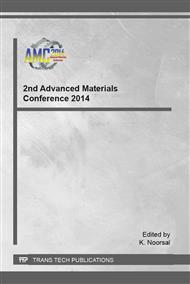[1]
Y. He, E.J. Susanne, P.L.J. Zitha, M. Golombok, Kinetics of CO2 and methane hydrate formation: An experimental analysis in the bulk phase, Fuel 90 (2011) 272 - 279.
DOI: 10.1016/j.fuel.2010.09.032
Google Scholar
[2]
L. Jensen, K. Thomsen, N.S. Solms, Inhibition of structure I and II gas hydrates using synthetic and biological kinetic inhibitors, Energy Fuels. 25 (2011) 17 - 23.
DOI: 10.1021/ef100833n
Google Scholar
[3]
P. Buchanan, A.K. Soper, H. Thompson, R.E. Westacott, J. L. Creek, G. Hobson, C.A. Koh, Search for memory effects in methane hydrate: structure of water before hydrate formation and after hydrate decomposition, J. Chem. Phys. 139 (2013).
DOI: 10.1063/1.2074927
Google Scholar
[4]
O. Fandino, L. Ruffine, Methane hydrate nucleation and growth from the bulk phase: Further insights into their mechanisms, Fuels. 117 (2014) 442 - 449.
DOI: 10.1016/j.fuel.2013.10.004
Google Scholar
[5]
C.A. Koh, Towards a fundamental understanding of natural gas hydrates, Chem. Soc. Rev. (2001) 157 - 167.
Google Scholar
[6]
S.R. Davies, E.D. Sloan, A.K. Sum, C.A. Koh, In situ studies of the mass transfer mechanism across a methane hydrate film using high-resolution confocal raman spectroscopy, J. Phys. Chem. C. (2010) 1173 - 1180.
DOI: 10.1021/jp909416y
Google Scholar
[7]
E.G. Hammerschmidt, Formation of gas hydrates in natural gas transmission lines. Ind. Eng. Chem. 8 (1934) 851 - 855.
DOI: 10.1021/ie50296a010
Google Scholar
[8]
E.D. Sloan, Clathrate hydrates of natural gases, Marcel Dekker, 2nd ed., (1998).
Google Scholar
[9]
N. Daraboina, J. Ripmeester, V.K. Walker, P. Englezos, Energ. Natural gas hydrates formation and decomposition in the presence of kinetic inhibitors. 1. high pressure calorimetry, Fuels 25 (2011) 4384 - 4391.
DOI: 10.1021/ef200812m
Google Scholar
[10]
P. Servio, P. Englezos, Methane–ethane and methane–propane hydrate formation and decomposition on water droplets, A.I. Ch. E 49 (2003) 269 - 276.
DOI: 10.1016/j.ces.2005.03.003
Google Scholar
[11]
J.D. Lee, P. Englezos, Unusual kinetic inhibitor effects on gas hydrate formation, Chem. Eng. Sci. 60 (2005) 4203 - 4212.
Google Scholar
[12]
D.L. Zhong, D.P. Liu, Z.M. Wu, L. Zhang, Natural gas hydrate formation and growth on suspended water droplet in: Proceedings of sixth international conference on gas hydrates, Vancouver, British Columbia, Canada, (2008).
Google Scholar


